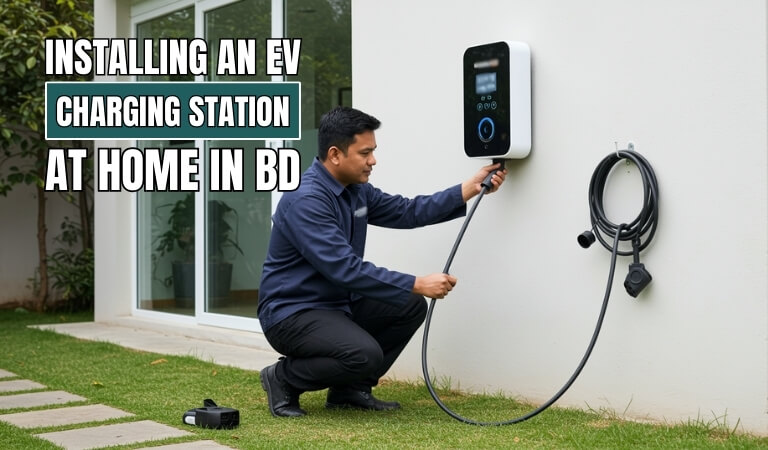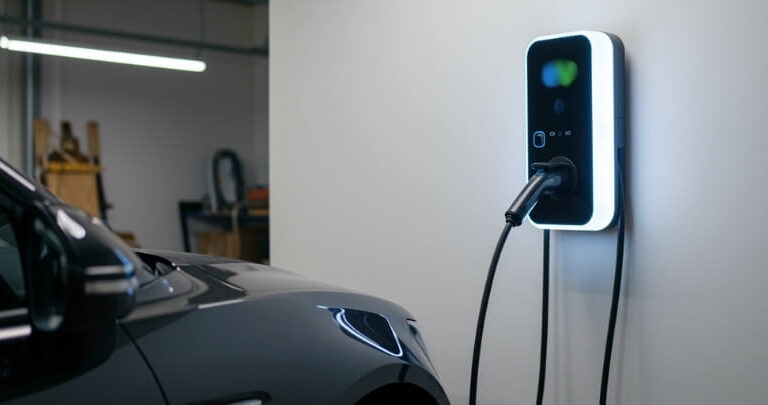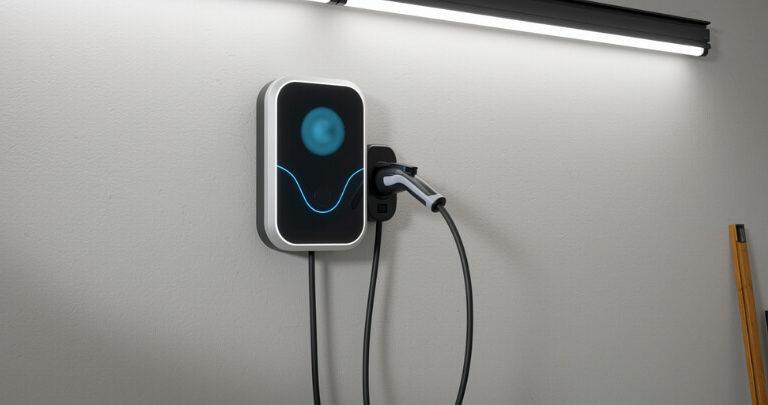Currently, electric vehicles (EVs) are gaining popularity in Bangladesh due to their eco-friendly nature and cost-effectiveness. As the adoption of EVs grows, many homeowners are looking to set up charging stations at home for convenience. However, a common question arises: How to install an electric vehicle charging station at home in Bangladesh?
Assess your electrical system, choose a compatible charger, get necessary permits, and hire a certified EV charging solution provider to install an EV charging station at home in Bangladesh. They’ll install, test, and ensure compliance with safety and local regulations.
These steps are crucial to ensuring a safe and efficient setup of your EV charging station. By following this advice, you’ll not only save time and money but also avoid common mistakes during the installation process. Read on to discover more about each step.
How to Install an Electric Vehicle Charging Station at Home in Bangladesh? (Step-by-Step)
If you own an electric vehicle (EV), you might be thinking about installing a charging station at home. But how do you do it? Don’t worry, we’ve got all the details for you. Let’s dive in:

Step 1: Check Your Home’s Power
Before doing anything, you need to know if your home’s electricity can handle a charger. Most EV chargers need more power than regular appliances. If your home’s power setup is old or too weak, it might need an upgrade. This is something an electrician can check for you. It’s better to be safe than to have problems later.
Step 2: Pick the Right Charger
There are different types of EV chargers. Some charge faster than others, and some have cool features like timers or apps. Make sure the charger you pick works well with your car. Think about how fast you want it to charge and where you want to install it. Choosing the right charger will save you time and effort.
Step 3: Get the Paperwork
In Bangladesh, you may need permission from local offices before you start installing. This is called getting a permit. It helps make sure everything is done safely and follows the rules. The expert who installs your charger can help with this. Don’t skip this part—it’s important.
Step 4: Call the Experts
Installing an EV charger isn’t something you should try on your own. It involves working with wires and electricity, which can be dangerous. That’s why it’s best to hire someone who knows how to do it right. Many professionals who install EV charging stations in Bangladesh have the tools and training to get the job done safely. They’ll handle everything safely and quickly.
Step 5: Install the Charger
Once the expert checks everything, they will start installing the charger. This means connecting wires from your electric panel to where the charger will be. They’ll also set up safety parts like grounding to protect your home. It usually doesn’t take too long. Just make sure it’s done properly.
Step 6: Test Everything
After the charger is installed, it needs to be tested. This is to make sure it’s working the way it should. The expert will turn it on and check if your car is charging correctly. If something is wrong, they can fix it right away. Testing helps avoid problems later.
Step 7: Follow the Rules
Every place has rules about how to do electrical work safely. These are called codes and safety standards. Your charger must follow these rules to keep your home and car safe. The expert you hire should know all these rules. Always double-check that everything is done the right way.
Step 8: Use It Safely
Now that your charger is ready, use it carefully. Don’t plug in wet hands or charge when it’s raining unless the charger is protected. Follow the instructions that come with the charger. Taking care of it will make it last longer. Charging at home is super easy once it’s all set.
Are There Any Incentives or Discounts for Installing EV Chargers in Bangladesh?
Yes, there are some incentives and discounts available for installing EV chargers in Bangladesh. These benefits are part of the push to support cleaner and greener transport. The government and some private groups want to make it easier for people to switch to electric vehicles. Because of this, they offer support to those setting up home or public charging stations.
Some of these benefits include reduced taxes on charging equipment and lower electricity rates for charging use. This can help lower the total cost of installing an EV charging station at home or for business use. In some areas, power companies may even offer special packages or discounts for EV users. These steps are taken to encourage more people to install chargers and go electric.
If you’re thinking about installing one, it’s a good idea to ask local service providers about any deals. You can also check with local electric offices for the latest rules and offers. While not all areas offer the same support, many places are starting to follow these programs. Taking advantage of these can save money and make charging at home more affordable and easier.
Key Benefits of Having a Personal EV Charging Station in Home
Having a personal EV charging station at home comes with many advantages. Not only does it save you time, but it also makes your life more convenient. Here are some key benefits of installing one.

Convenience of Charging
One of the best things about having your own EV charger is convenience. You can charge your car anytime, without worrying about finding a public charging station. No more waiting in line or worrying about the charger being in use. Simply plug in your car when you get home and start your day with a full charge.
Saves Time and Effort
With a home charging station, you don’t need to leave your house to find a place to charge your vehicle. This saves you a lot of time and effort, especially if public stations are far away or crowded. Charging at home allows you to wake up every day to a fully charged car, ready to go. It’s all about making your life easier.
Cost-Effective
While there is an initial cost to install a home charger, it can save you money in the long run. Public chargers often cost more per unit of electricity, and some may even charge extra fees. Charging at home means you pay at home rates, which are generally cheaper. This can add up to significant savings over time.
Control Over Charging
When you have a personal EV charging station, you’re in control. You can decide when to charge your car, how much to charge, and even set schedules for off-peak hours to save on electricity costs. This level of control gives you peace of mind and flexibility.
Environmental Impact
By having an EV charging station at home, you’re also helping the environment. Electric vehicles produce fewer emissions compared to traditional gas-powered cars. Charging at home with clean energy can reduce your carbon footprint. It’s an easy way to do your part in protecting the planet.
Increases Property Value
Having an EV charging station can even increase the value of your home. More and more people are looking for homes with eco-friendly features. If you ever decide to sell your home, the presence of a charging station can make it more appealing to potential buyers, especially those who own electric cars.
Things to Consider Before Buying an EV Charger for Home Installation in Bangladesh
Electric vehicles are becoming more popular in Bangladesh, and many people are now thinking about setting up chargers at home. But before buying one, there are a few important things you need to think about first. These small checks can help you avoid problems later. Keep reading to understand what to look out for before making a choice.

Charger Type
There are different types of EV chargers, and not all of them are the same. Some charge faster, while others are slower but cheaper. When choosing a charger, consider EV charger pricing, as this can vary based on the type and features. Think about how often you drive and how fast you want your car to charge. A good match means less waiting and more convenience.
Smart Features and Control
Some EV chargers offer features like mobile apps, usage tracking, or charging timers. These smart tools let you control when and how much you charge. They’re helpful for saving electricity and monitoring costs. While not a must, choosing a smart charger gives you more flexibility and long-term convenience.
Brand and Build Quality
Not all EV chargers are the same. Research local brands and read reviews before making a decision. Pick a charger with strong build quality and certified safety standards. A durable product will last longer and perform better. Don’t be tempted by the cheapest option—go for trusted and tested equipment.
Warranty and Support
Before buying a charger, check if it comes with a warranty and local support. A good warranty period means better reliability. If any issues come up, local service centers make it easier to get quick help. Don’t skip this—after-sales support can save you time and money later.
Power Backup Options
Power cuts are common in many areas of Bangladesh. If this applies to your location, ask if the charger supports backup power like an inverter or solar system. Having a backup ensures you can charge anytime, even during outages. It’s a smart way to stay prepared and avoid charging delays.
Future-Proofing Your Setup
Think ahead when choosing a charger. You may buy another EV in the future or upgrade to one that charges faster. Look for chargers that support higher power or dual-port use. This way, you won’t have to replace everything again. Planning now can save both money and effort later.
Can You Upgrade or Expand Your Home Charging Setup Later?
Yes, you can upgrade or expand your home charging setup later if needed. Many people start with a basic setup first. As their needs grow or they get a new car, they choose to upgrade. This makes it easier to charge faster or add more features later.
Some people may want a faster charger in the future for quicker charging. Others may need a second charger if they buy another electric car. Your home setup can be changed to handle this if planned properly from the start. It’s helpful to talk with an expert to make sure your system allows easy changes later.
Before upgrading, check if your home’s electric panel can support more power. If not, it might need an upgrade before adding new chargers. Some homes already have enough power to add more without any extra work. Planning ahead can save money and avoid bigger changes later.
Common EV Charging Station Post-Installation Issues and Solutions
Installing an EV charging station at home is a smart move, but sometimes small problems can show up afterward. These issues are usually easy to fix once you know what to look for. Here’s a simple list of common post-installation problems and how you can solve them.
- Charger Not Turning On: Check the power supply and circuit breaker to make sure everything is working. A loose connection can also cause this problem.
- Slow Charging Speed: This could be caused by a weak power line or low voltage. Always check the wiring and use the right charger type.
- Charging Stops Midway: Overheating is one reason why charging may stop. Make sure your charger has proper ventilation and isn’t placed in direct sunlight.
- Car Not Recognizing Charger: Sometimes the plug isn’t fully connected, or the cable is damaged. Try reconnecting or using a different charging cable if possible.
- Wi-Fi or App Issues: Some smart chargers use apps that need a strong internet connection. Keep your Wi-Fi signal strong and update the app regularly.
- High Electricity Bills: Charging during peak hours can increase your bill. Use a timer or smart charger to charge during off-peak hours instead.
- Cable Wear and Tear: Daily use can damage the cable over time. Always store the cable properly and avoid bending it too sharply.
- Unexpected Shutdowns: This may be due to power surges or an unstable electric supply. Use a surge protector and have an electrician check your setup.
Frequently Asked Questions
Installing an electric vehicle (EV) charging station at home in Bangladesh is a popular choice for many EV owners. If you’re considering setting one up, you might have several questions. Here are some frequently asked questions that will help you through the process and provide useful information:
How Much Space Is Needed to Install a Home EV Charger?
You don’t need a large space to install a home EV charger. A small area near your parking spot with access to electricity is enough. Make sure there’s enough room to safely plug and unplug the charging cable. It’s best if the space stays dry and protected.
Can I Share My Home EV Charger With a Neighbor?
Yes, you can, but it should be planned properly. You’ll need a clear agreement on electricity costs and usage schedules. It’s also important to check if your charger can handle frequent shared use. A dual-port charger may be a better choice for shared charging.
What Is the Lifespan of a Home EV Charger?
Most home EV chargers can last anywhere between 8 to 10 years if taken care of properly. Regular maintenance and using the charger under safe conditions can extend its life. Avoid overloading or leaving it in harsh weather. Good care makes a big difference.
Do I Need the Internet for My EV Charger to Work?
Not all chargers need the internet to function. However, smart chargers often require Wi-Fi for extra features like remote control and charging reports. If you want those benefits, a stable connection is helpful. But for basic charging, the internet is not a must.
What Happens If the Power Goes Out While Charging?
If the electricity cuts off during charging, the process will simply stop. Your car and charger are designed to handle this safely. Once power returns, most chargers will restart automatically or allow manual restart. There’s no damage to the battery in such cases.
Can an EV Charger Be Installed Without Drilling Walls?
Yes, in many cases, chargers can be wall-mounted using existing support or placed on a stand. Some setups allow surface wiring to avoid drilling. It depends on your space and layout. Talk to your installer for clean and drill-free options if needed.
Is It Safe to Install a Charger Close to Water Sources?
No, it’s not recommended to install chargers near water sources like outdoor taps or drains. Water and electricity together are dangerous. Always keep your EV charger in a dry, sheltered place. If needed outdoors, use a weatherproof unit with a secure cover.
Final Thoughts
Setting up your own EV charger at home can feel like a big step, but it’s actually simple when you follow the right process. With more people switching to electric vehicles in Bangladesh, charging at home is quickly becoming a must-have for comfort and savings.
If you’re unsure how to install an electric vehicle charging station at home in Bangladesh, the solution lies in planning wisely, picking the right equipment, and getting expert help. From checking your home’s power system to choosing a safe, weather-ready charger, each step plays a significant role in the process.
Take the time to understand your needs, explore any local offers or discounts, and make choices that fit your daily routine. With the right setup, you’ll not only make your life easier but also reduce the amount of clutter on your drive.
